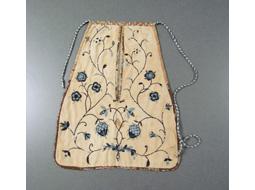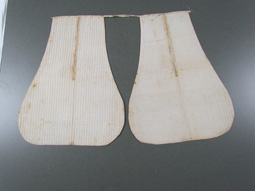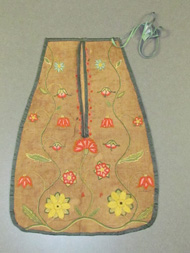Picking the DAR Museum's Pockets

“Lucy Locket lost her pocket
Kitty Fisher found it
There was not a penny in it
But a ribbon ‘round it”
How many of you recited this poem when you were a child? Did you give the words much thought? How could a little girl lose her pocket? Why was there a ribbon ‘round it? After you read this post, you will have answers to all these questions!
 Pockets were not always inset in garments as we know them today. From the end of the 17th century to the early 19th century pockets were detached, and tied around a woman’s waist. They were not sewn into women’s garments because they would ruin the line of women’s gowns. They were more akin to our purses in the 17th and 18th centuries and so women carried a large variety of items from sewing tools, books and letters to gloves, cash and teaspoons. This weight would have pulled on one side of the gown. Another reason that pockets were not yet sewn in was that clothing was often remodeled during these centuries. It could be remodeled to fit someone else, and also to keep up with current fashions. Inset pockets would have generated more work when reworking the clothing.
Pockets were not always inset in garments as we know them today. From the end of the 17th century to the early 19th century pockets were detached, and tied around a woman’s waist. They were not sewn into women’s garments because they would ruin the line of women’s gowns. They were more akin to our purses in the 17th and 18th centuries and so women carried a large variety of items from sewing tools, books and letters to gloves, cash and teaspoons. This weight would have pulled on one side of the gown. Another reason that pockets were not yet sewn in was that clothing was often remodeled during these centuries. It could be remodeled to fit someone else, and also to keep up with current fashions. Inset pockets would have generated more work when reworking the clothing.
 Women usually wore their pockets under their skirts, or petticoats, with the center access slit lined up with the petticoat slit, allowing the hand to reach directly into the pocket. Pockets were occasionally worn under the apron, for working women who needed quicker access. Still, both the apron and the petticoat acted as another layer of protection against possible thieves.
Women usually wore their pockets under their skirts, or petticoats, with the center access slit lined up with the petticoat slit, allowing the hand to reach directly into the pocket. Pockets were occasionally worn under the apron, for working women who needed quicker access. Still, both the apron and the petticoat acted as another layer of protection against possible thieves.
 Women’s detached pockets were often elaborately decorated. The DAR Museum has six single pockets and three pairs of pockets in the collection. Most are whole cloth or embroidered. The plain, whole cloth pockets are considered to be utilitarian, functional. These pockets are usually made from a single piece of fabric, occasionally pieced, with a center slit for access, and a top binding to which ties are attached.
Women’s detached pockets were often elaborately decorated. The DAR Museum has six single pockets and three pairs of pockets in the collection. Most are whole cloth or embroidered. The plain, whole cloth pockets are considered to be utilitarian, functional. These pockets are usually made from a single piece of fabric, occasionally pieced, with a center slit for access, and a top binding to which ties are attached.
The DAR Museum houses three pairs of pockets, all whole cloth pockets. They were mostly white or woven striped dimity, similar to a seersucker.
 Another common type of pocket is the embroidered pockets, of which the DAR Museum has four. Embroidered is the most common type of decoration on pockets. Crewel embroidery, using twisted 2-ply worsted yarn as the thread, was the most common, although the DAR Museum has a silk embroidered pocket.
Another common type of pocket is the embroidered pockets, of which the DAR Museum has four. Embroidered is the most common type of decoration on pockets. Crewel embroidery, using twisted 2-ply worsted yarn as the thread, was the most common, although the DAR Museum has a silk embroidered pocket.
All of the DAR Museum’s embroidered pockets feature vines, flowers and leaves. The embroidery stitches used are Roumanian couching, flat stitch, ladder stitch, chain, bouillion, fishbone and a few others. The makers favored reds, blues, greens and yellows.
Now we know that little Lucy Locket lost her pocket probably because her ties came undone, and it fell from her waist. The ribbon ‘round it helped keep it closed, and prevented the contents from spilling out.


 Today's DAR
Today's DAR